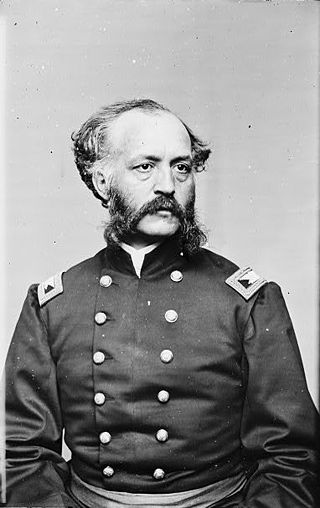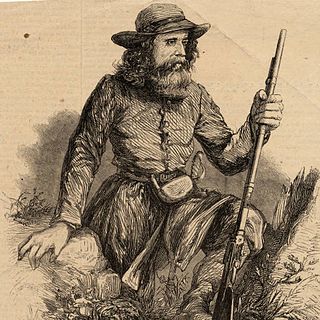Related Research Articles

Hiram Berdan was an American engineer, inventor, military officer, marksman, and guiding force behind and commanding colonel of the United States Volunteer Sharpshooter Regiments during the American Civil War. He was the inventor of the Berdan rifle, the Berdan centerfire primer and other weapons and accessories.

Private Truman Head, commonly known as "California Joe", was a famous member of the 1st United States Sharpshooters during the American Civil War. He served under inventor Colonel Hiram Berdan.
The infantry in the American Civil War comprised foot-soldiers who fought primarily with small arms, and carried the brunt of the fighting on battlefields across the United States. Historians have long debated whether the evolution of tactics between 1861 and 1865 marked a seminal point in the evolution of warfare. The conventional narrative is that generals and other officers adhered stubbornly to the tactics of the Napoleonic Wars, in which armies employed linear formations and favored open fields over the usage of cover. Presumably, the greater accuracy and range of the rifle musket rendered that approach obsolete, and the Civil War armies' transition to longer battles in 1864 is taken by numerous scholars as proof of the new technology's transformative impact. More recently, however, academics have begun to reject this narrative. Earl J. Hess judges the tactical training of the Civil War as critical to the armies' success, and maintains that the dearth of overwhelming victories during the conflict was actually consistent with the infrequency of such battles throughout history. Allen C. Guelzo contends that rifle muskets did not revolutionize land warfare due to a combination of inadequate firearms training and the poor visibility caused by black powder. This debate has implications not only for the nature of the soldier's experience, but also for the broader question of the Civil War's relative modernity. Williamson Murray and Wayne Wei-Siang Hsieh argue that the conflict was resulted from "the combination...of the Industrial Revolution and French Revolution [which] allowed the opposing sides to mobilize immense numbers of soldiers while projecting military power over great distances." The War involved a number of other recently introduced and new technologies, including military balloons, repeating rifles, the telegraph, and railroads.

The 22nd Regiment Massachusetts Volunteer Infantry was an infantry regiment in the Union army during the American Civil War. The 22nd Massachusetts was organized by Senator Henry Wilson and was therefore known as "Henry Wilson's Regiment." It was formed in Boston, Massachusetts, and established on September 28, 1861, for a term of three years.

The State of Michigan raised a number of Battalion and Company-sized specialist sharpshooter units in addition to the 1st Regiment Michigan Volunteer Sharpshooters.
The 1st United States Sharpshooters were an infantry regiment that served in the Union Army during the American Civil War. During battle, the mission of the sharpshooter was to kill enemy targets of importance from long range.

The 2nd United States Sharpshooters was a sharpshooter regiment that served in the Union Army during the American Civil War. From 1861 to January 1863 they were members of the "First Iron Brigade" also known as the "Iron Brigade of the East".

The 1st Michigan Sharpshooters Regiment was an infantry regiment that served in the Union Army's Army of the Potomac during the American Civil War.

George Emerson Albee was an officer in the United States Army who received the Medal of Honor for his actions during the Indian Wars. During the Civil War, he fought with Berdan's Sharpshooters, the Wisconsin light artillery, the U.S. Colored Infantry, and the U.S. Regular Army.

The Eastern Iron Brigade, also known as the Iron Brigade of the East and First Iron Brigade, was a brigade of infantry, that served in the Union Army's Army of the Potomac, during the American Civil War. For much of its service, it was designated as the 1st Brigade, 1st Division, I Corps. Among its commanding officers were General John P. Hatch and General Walter Phelps Jr. Noted for its reliability in battle, the brigade developed a reputation which remained after it was disbanded late in the war, due to its annihilation from extremely high casualties.

Schützen is a German plural noun used to designate a type of military unit of infantrymen, originally armed with a rifled musket and used in a light-infantry or skirmishing role – and hence similar to the Jäger. The individual infantrymen are termed Schütze. Prior to the introduction of firearms the word was used for 'archer', and is sometimes used in the form Bogenschütze.
The 66th Illinois Veteran Volunteer Infantry Regiment (Western Sharpshooters) originally known as Birge's Western Sharpshooters and later as the "Western Sharpshooters-14th Missouri Volunteers", was a specialized regiment of infantry sharpshooters that served in the Union Army during the American Civil War. The regiment was intended, raised, and mustered into Federal service as the Western Theater counterpart to Army of the Potomac's 1st and 2nd United States Volunteer Sharpshooters ("Berdan's Sharpshooters").

The Iron Brigade, also known as The Black Hats, Black Hat Brigade, Iron Brigade of the West, and originally King's Wisconsin Brigade was an infantry brigade in the Union Army of the Potomac during the American Civil War. Although it fought entirely in the Eastern Theater, it was composed of regiments from three Western states that are now within the region of the Midwest. Noted for its strong discipline, its unique uniform appearance and its tenacious fighting ability, the Iron Brigade suffered the highest percentage of casualties of any brigade in the war.
The Thirteenth Pennsylvania Reserve Regiment, also known as the 42nd Pennsylvania Volunteer Infantry, the 1st Pennsylvania Rifles, Kane's Rifles, or simply the "Bucktails," was a volunteer infantry regiment that served in the Union Army during the American Civil War. It was a part of the famed Pennsylvania Reserve division in the Army of the Potomac for much of the early and middle parts of the war, and served in the Eastern Theater in a number of important battles, including Antietam, Fredericksburg, and Gettysburg.

A sharpshooter is one who is highly proficient at firing firearms or other projectile weapons accurately. Military units composed of sharpshooters were important factors in 19th-century combat. Along with "marksman" and "expert", "sharpshooter" is one of the three marksmanship badges awarded by the United States Army and the United States Marine Corps. The United States Navy and the United States Coast Guard use a ribbon with an attached "S" device to note a sharpshooter qualification.

Walter Goodale Morrill was a Union Army officer in the American Civil War and a recipient of the U.S. military's highest decoration, the Medal of Honor, for his actions at the Second Battle of Rappahannock Station in November 1863. Also, Morrill's earlier actions in July 1863 at Gettysburg are considered essential for the famous Union victory on Little Round Top.
The Chew's Arkansas Infantry Battalion (1862) was a Confederate Army infantry battalion during the American Civil War. The unit was originally known as Hawthorne's Battalion, but the battalion is most often referred to as Chew's Sharpshooter Battalion. The unit was eventually consolidated with the 39th Arkansas Infantry Regiment.
Company G, 1st U.S. Sharpshooters was an infantry company that served in the Union Army during the American Civil War. The unit is sometimes unofficially referred to as the 1st Wisconsin Sharpshooters.

The 1st Company Massachusetts Sharpshooters was a sharpshooter unit in the Union Army during the American Civil War.
The Battle of Rome Cross Roads, also known as Battle of Rome Crossroads, Skirmish at Rome Crossroads, or Action at Rome Cross-Roads was part of the Atlanta Campaign of the American Civil War. It was fought in Gordon County, Georgia, a short distance west of Calhoun, Georgia, on May 16, 1864. The battle was a limited engagement between Union Army units of the Army of the Tennessee and Confederate States Army units of the Army of Tennessee in the aftermath of the Battle of Resaca, Georgia.
References
- ↑ "First Minnesota Volunteer Infantry Regiment". 1stminnesota.net. Retrieved 2014-03-04.
- ↑ "History – Minnesota Infantry (Part 1)". Civilwararchive.com. Retrieved 2014-03-04.
- 1 2 3 "2nd Company Minnesota Sharpshooters". Civil War Index. Retrieved 2014-03-04.